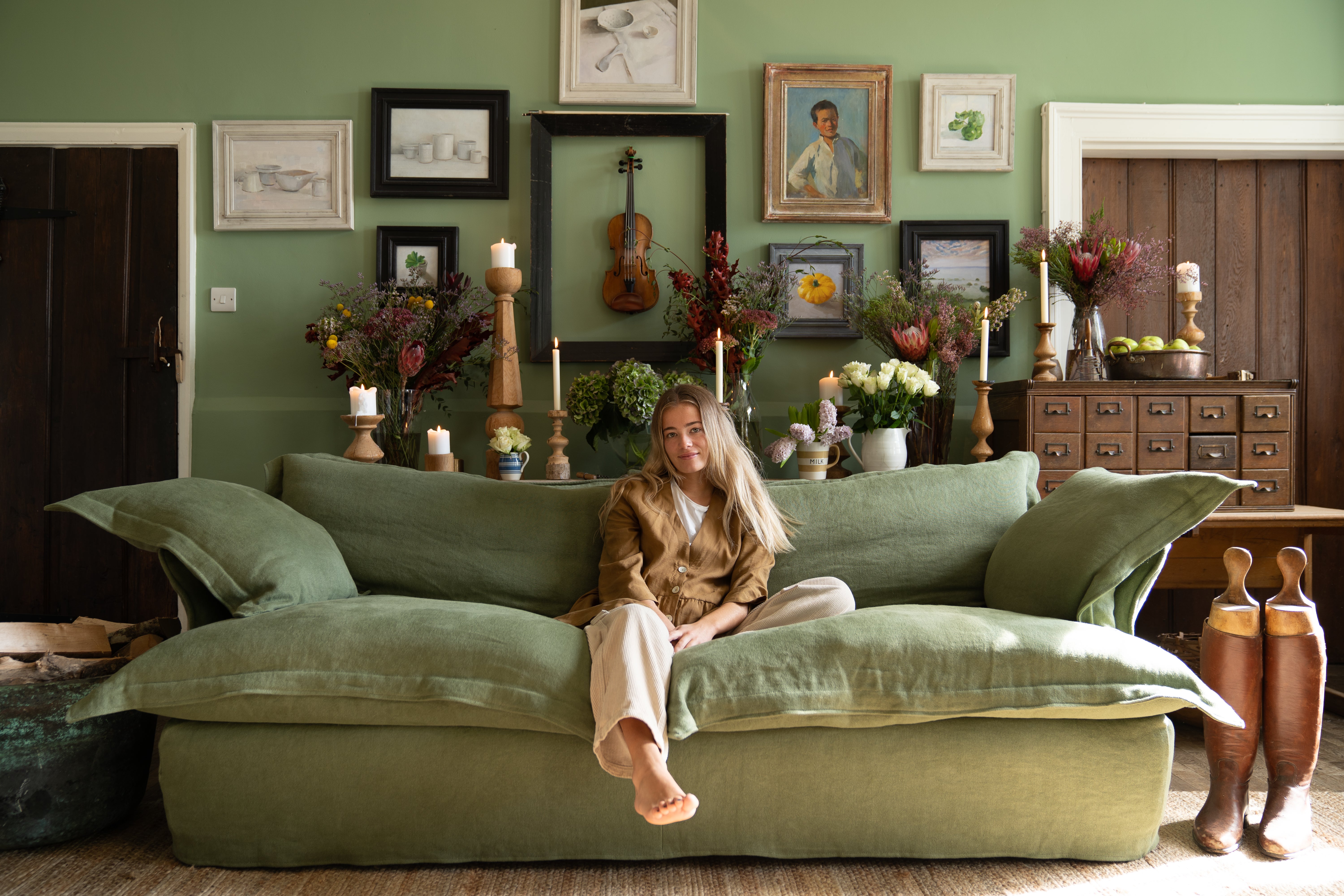In an era of multihyphenates, it’s not uncommon for careers to cover a lot of ground—but Alex Willcock has truly gotten around. The British entrepreneur’s resume includes cabinetmaking; retail operations, management, buying and design; corporate responsibility; and big-data marketing. His latest venture, Maker&Son, is a fitting amalgam: a direct-to-consumer furniture company that makes all-natural sofas, armchairs and beds that are manufactured locally and sold in large part through vibrant, personal imagery. (Lose yourself in the slow-motion clip of Marnie, a family friend, catapulting into a plush five-seater sofa in a quintessentially British living room, set to a 1906 Gabriel Fauré piano quintet.)
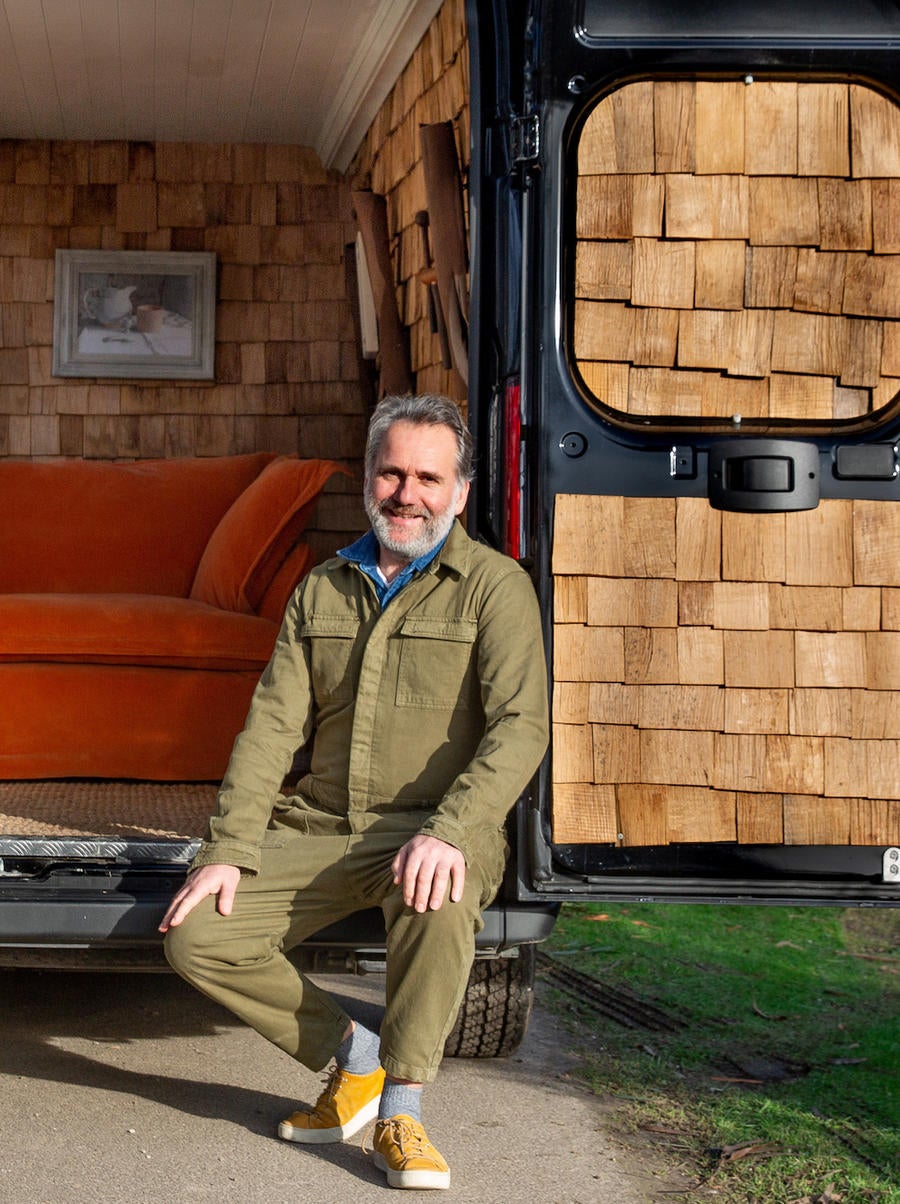
Though the company launched in 2018 in the United Kingdom, Willcock and his co-founder, his son Felix Conran, were quickly inundated with requests from Australia—and within eight weeks, had forged a partnership with a local manufacturing partner to fulfill orders without the environmental burden of international freight. A made-local ethos is paramount to the brand: Each piece is made in the country where it’s sold, and materials (including feathers, themselves byproducts of meat markets) are sourced locally.
As Willcock and Conran tested their arrangement in Australia, they had to block U.S. visitors from their site, so great was consumer interest. But following the exercise’s success, Maker&Son has partnered with Lee Industries to bring its products stateside. The company also opened an appointment-only New York showroom in SoHo—a live-work space that houses Conran and his girlfriend, and offices a small U.S. team.
BOH visited Willcock in the new showroom to ask about the challenges of developing a completely eco-friendly product, why they didn’t design with a price point in mind, and how a fleet of mobile vans is the key to the company’s growth in all three of its markets.
What influenced your decision to focus on natural materials?
Fundamentally, if you’re going to create something that is environmentally sound, it’s not just about what it’s made from. It’s also how it’s made and where it’s made. And then it’s how long it’s going to last.
I feel like brands struggle to hit all of those.
When you think about how long something’s going to last, you’ve got to think about whether or not someone’s going to want it, as well as if it’s it’s actually holding up, physically. We want the people that own our pieces to find their children fighting over them when they’ve gone.
I started designing furniture 37 years ago—I went to furniture college and started designing when I was [around] 18. During that early stage in my career, I was designing upholstered pieces for retail. I got headhunted to start the retail chain [Country Road] in Australia in my 20s. Later, probably the biggest part of my design career was when I was running the Conran Shops globally. [The U.K.-based department store chain has multiple locations in London and Paris, as well as outposts throughout Korea and Japan.] I was head of buying, creative director, and designing. A lot of what we did was fashion-led—we were designing things that we felt were of the moment. I decided not to do that with Maker&Son. I decided to create something that was about really one thing: making people feel really, really comfortable. It was about creating something that you’re theoretically going to be happy with in 50 years.
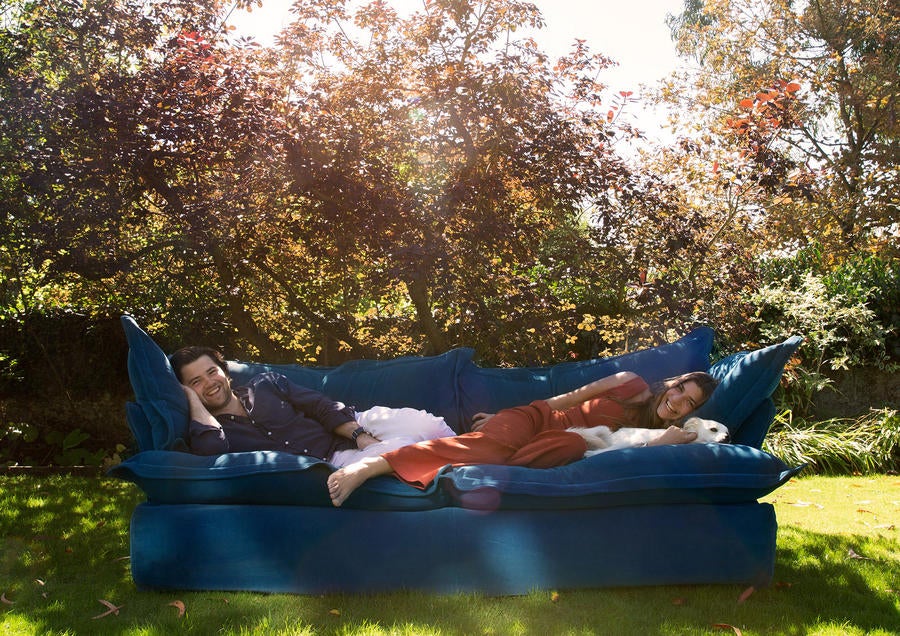
How does corporate responsibility factor into your process and mission?
When I was at Conran, I implemented a corporate social responsibility strategy for them. Long story short, we did a lot of research in India around our suppliers, and all of them were working, actually, to really good standards. But then we started looking at their subcontractors. Then we looked at the subcontractors of the subcontractors. And we discovered some unpleasant things. As a result of that, we started this education foundation, which then led to a school being created. I went to visit that school and it changed my life.
What was it that was so transformative about it?
It was in the days before the internet. I’d [basically] started this thing through intention, faxes and phone calls, and setting up a team in India to go visit all of the factories. In certain cases, there were over 20 subcontractors building one product, with different people [each] supplying one component. We discovered that there were children producing certain components of what we were selling. When we looked into that, the knee-jerk reaction was, “Well, stop working with them.” Actually, the reality is, you start doing that and you destroy livelihoods completely.
So, it’s a long way to say that [on a return trip], going to visit that school for the first time—I realized, if you can [start a school that changes lives] with just with a fax and a few phone calls, what could you do if you dedicated your whole life to it? So then, [in 1999], I jumped into running an agency [called Nest] that was completely dedicated to helping companies execute corporate responsibility policies. We did some really great things.
After that, I started VisualDNA [in 2006], a marketing, big-data business that combined psychology with data. The reason is that all along in my career I’ve learned about making emotional connections with people through product, through communication. I wanted to make that into a product. This journey, now, of running Maker&Son combines [all of those elements]. Because I’d run a tech company for five years, I had learned the principles of test and learn, and fail fast.
So we put two and a half years into the development of the [Maker&Son] product—and making a product entirely from natural materials is quite a pain. It’s not easy.
What were the biggest hurdles?
It’s a few things. It’s not just the sourcing of some of the materials—cotton, wool and natural fibers such as coconut fiber. Layering those things [to create the piece’s structure] as opposed to just slapping a piece of foam on the side, it takes forever.
[Beyond] the materials, it’s about getting to a point that you can combine all of those in the right way. We made a decision that we were not going to decide on a price point and then engineer to that price. We decided to engineer it to be the most comfortable thing that we have ever sat in, and then figure out what that costs. That took about two and a half years, and then we launched it [in the U.K.].
Soon after launching on Instagram, we had one or two thousand followers. And then we launched the products on our website. Amazingly enough, our first orders actually came from Australia, which was bizarre.
But your manufacturing partner was in the U.K., right?
Yeah. And then we thought: Hang on. There’s no way we can be an environmentally friendly company and ship a sofa from the U.K. to Australia. And because I’d run a chain over there, I had contacts there, I flew over and spoke to two people I trusted, who both recommended the same manufacturer. I had an hour-and-a-half meeting [with them], we had a handshake deal, and I think it was less than eight weeks, we were shipping from there. They’re a company that employs 100 to 150 people, has been going for over 30 years, started by a couple and their four children and their kids’ partners. They’re amazing.
Then, we were so deluged by U.S. inquiries that we had to stop access [to the site] from here because we couldn’t cope. Australia was sort of like a test for us: Would it be possible to create product within the U.K., [run the] brand from there, market from there, and have a manufacturing and sales arm locally? And it just instantly worked.
Do you have a showroom in Australia, as well?
No.
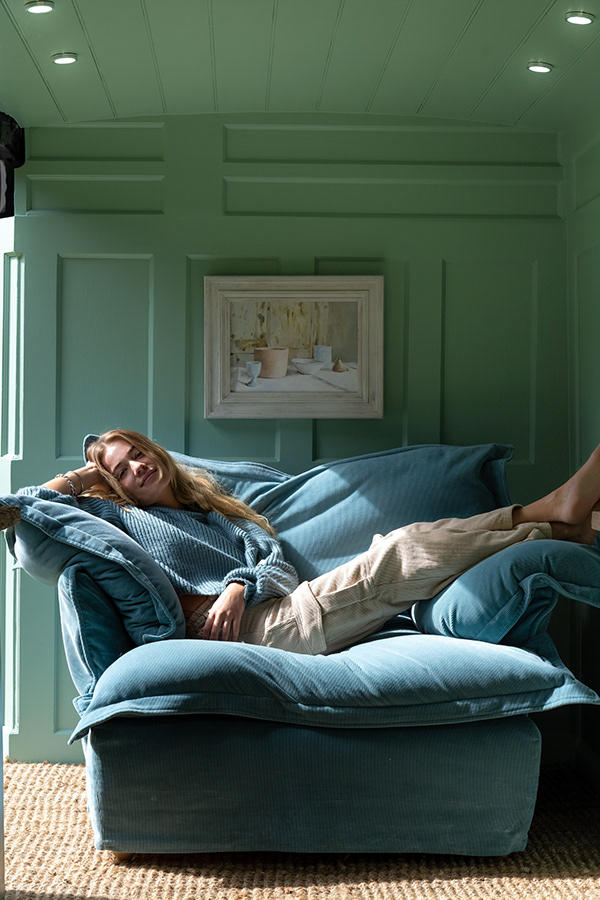
So it’s all drop-shipped from the manufacturer?
Yes—that, and we have our mobile vans [that we use to drive and show people the sofas]. Here’s a picture of one of the vans [see above]. And we made the interiors from recycled doors, which we turned on their sides.
It’s gorgeous, it looks like paneling. What’s the range for this—how far would you go?
In the U.K., a long way. We’ll drive up to Scotland. We have three of these permanently on the go [there].
Instead of a physical location?
Yes. Everyone loves it. Of course, the only way it’s possible is we do one thing, and we do one thing really well. And inside, there are all the fabric swatches. ... I mean, honestly, they are pretty cute things. That’s the distribution.
The usual [consumer] journey is someone sees the ad—they’re very emotionally engaging. We rarely talk about trying to sell you something; it’s about the benefit of becoming that comfortable. When you become that comfortable, a whole lot of amazing things happen. You’re not just physically comfortable, you’re mentally comfortable. So people go to the website and fill out a contact form. Then we have a team of people that contact them by their preferred methods—by text, WhatsApp, what have you. And then we make appointments to go see them.
And then you place your order, in theory, in the van?
A lot of them end up being made then. And we also have a free space-planning service. If we go into someone’s home, we can take photographs and dimensions. We have a young architect who [handles space planning]. The team will get the measurements to him and then usually it’s turned around within a couple of hours. And then the client gets their floor plan and layout [options]. It creates very high conversions.
You have a showroom here in New York—does that herald more brick-and-mortar locations for the brand?
No—no stores. Well, I’m not going to say never. But the reason for this [showroom space in New York] is that we live here, we have this space, and a team that works here. But the main way the business is going to grow is through a network of mobile showrooms across the U.S.
Has moving into the U.S. market been different from Australia or the U.K.?
It’s still very young, but my general sense is that across the world, people are waking up to so many different things. I don’t know whether the same has happened in the U.S., but in December there was a downturn in fast fashion in the U.K. And that’s grassroots—ordinary people making big decisions. And what I think is fascinating is that until fairly recently, those decisions have [only] been made by people that can afford to make those decisions. In our experience to date, the majority of this market is at the low- to mid-end, whereas ours is mid- to high-end.
When I looked online, one of the first things I noticed is that yours is one of the higher price points I’ve seen for a sofa that you buy online. Have people been scared off by that?
We just say: Look, there’s a 100 percent money back guarantee, which we’re probably legally obliged to say anyway. But it’s at that price point. Our average sale is, in dollar terms, it’s over $10,000. And yeah, that is quite a big thing for someone to commit to without having sat in it. We’re increasingly putting energy into the website content and there are some really nice reviews there. It’s all about authenticity.
For that $10,000 order, what are people buying? What kind of combination or configuration of things?
Typically, it will be the three- to four-seater sofa, plus an armchair and a footstool. That’s average. It could be two of those three-seater sofas. There’s the L-shape. It could be any number of things.
You look at [our competitors’ products], and their rents, the cost of employing people—that comes at a massive cost. And the person who is ultimately paying for it is a customer. So, a product like ours, which will compare with higher-end pieces, has [better] engineering [than competitor products]. Generally, people are a long way from being stupid, [and they’re starting to wonder], Why pay for that when I don’t need to? A high-end store is going to mark up somewhere between three and four times the cost because they have to. Because if they don’t, they lose money, and so many of them are losing money even when they are marking up by that level. [What we’re doing is] disruptive, but then, someone’s got to do it.
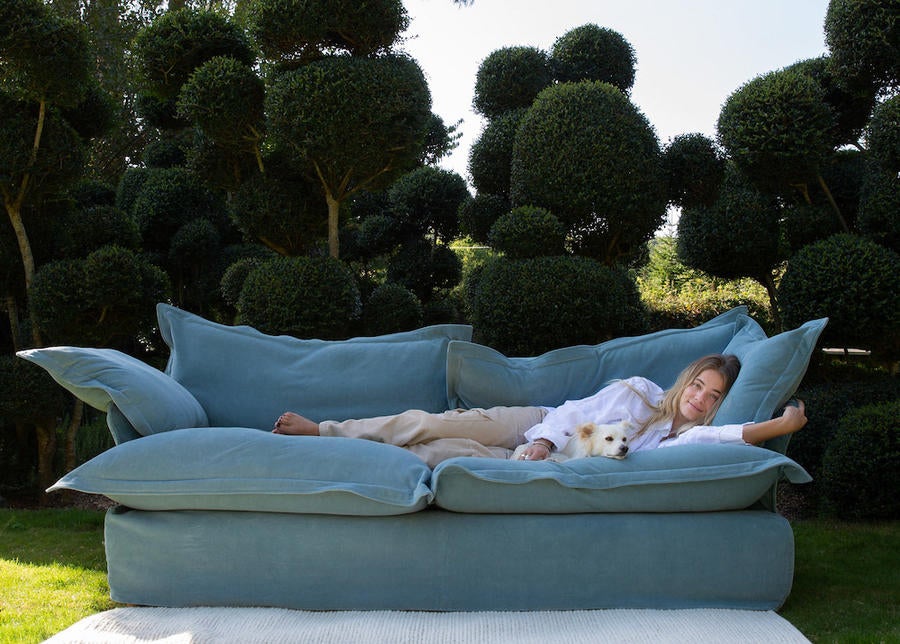
How did you find Lee as your U.S. manufacturing partner?
They found us. Someone wrote to me on LinkedIn saying, “Hey, we love what you’re doing. Could we manufacture for you?” And then my son Felix went over and saw them. They’re the nicest people. We’re buying a high-end product from them, which has ultimately enabled Lee to support the people they buy from. There’s a lot of good that comes out of [the partnership]. This year’s going to be a big year for us both. We’re excited about it.
Let’s talk about the designer market—I know it’s important to you here. Has that been something you’ve cultivated in the U.K. and in Australia?
In Australia, it’s being cultivated way more than in the U.K. In the U.K., a good chunk of our customers will say to their designers, “I’ve seen this. Add this to the scheme.”
Because of the way we operate, we don’t have anything like the margin of a retailer, so we’re not able to give anything like a discount. Some retailers give designers a huge discount. If we gave anything like that, we would sell less than our cost. So there are some things [we have] to get people’s heads around. We can give designer discounts, and we do, but it’s nothing like what people expect. [We help] people understand how it’s made, what it’s made from, what the real cost is.
Why do you think people are willing to pay?
Here’s another interesting story. So this [100-percent linen textile] is priced at 20 percent more than the standard cotton-linen, which is our entry price level. We’ve had this on range now for maybe four months, and no kidding, within a few weeks it became our bestselling fabric. What people want is something amazing.
Does that mean your customer is not necessarily a price-conscious shopper?
Some people genuinely save up for this, and there are others that just don’t think about it. [Introducing] this [fabric] was a really big decision for us. It was like, “Oh, my god, we’re going to commit.” It was an enormous amount of money. It’s paid off, because people really responded. And I’d like to think that we could get that right every time. There’s something wonderful about being able to make decisions like that when you get to a certain scale. And equally, we do COM, so working with other people’s fabrics is fun, as well. I’d like to do more of that.
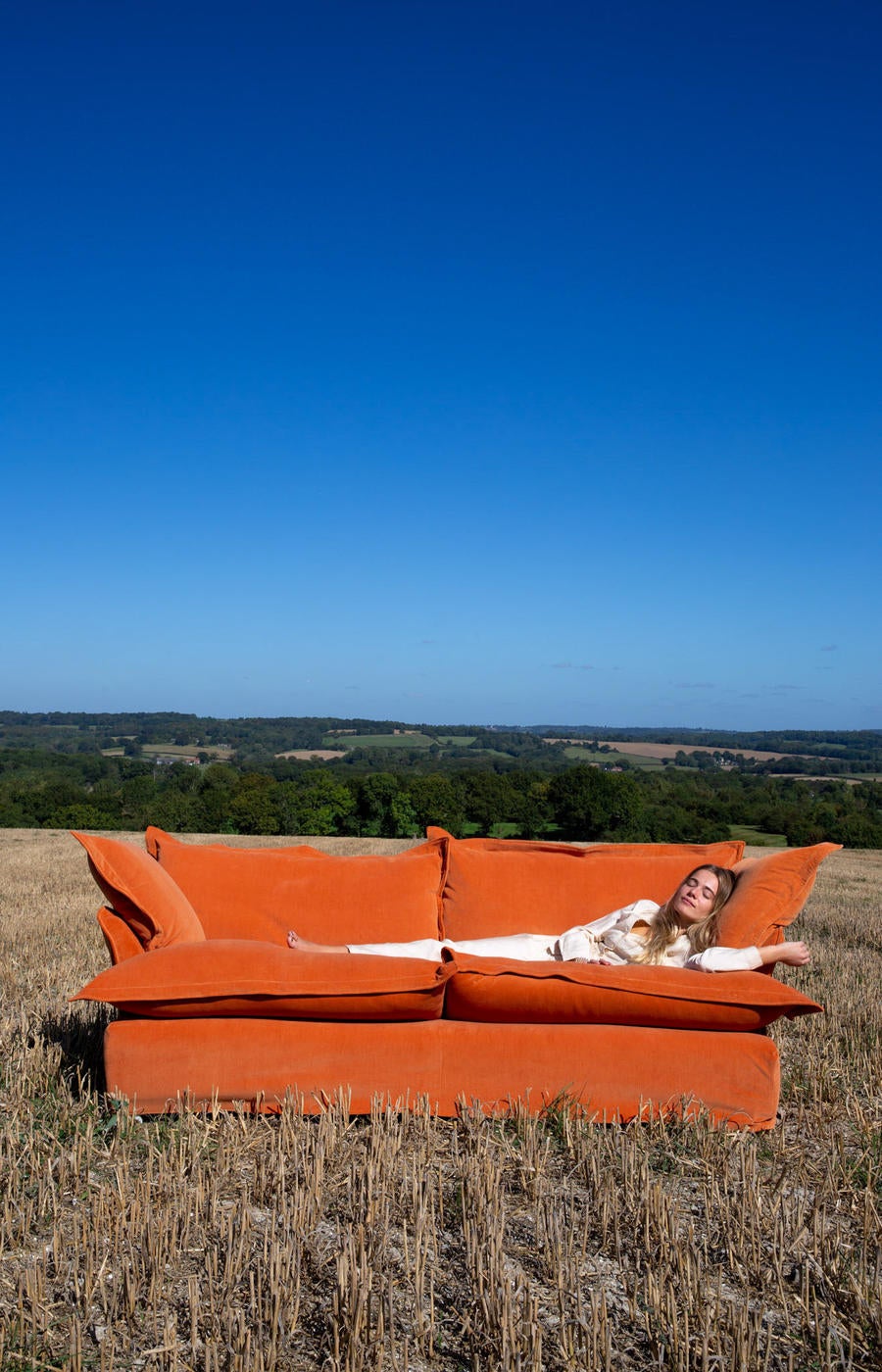
You talked about the idea of doing one thing really well. But do you see expanding into other rooms and product categories?
Absolutely. There’s a thing [we’ll be launching] where we’re using exactly the same construction, just a different style of cushion. Frankly, it looks a lot more ordinary, and for some people, that might be a selling point. It’s more formal. Less casual. There are all sorts of other things that we will do. The bed range, that’s happening. There are lots of things planned, but right now bringing this to a wider audience is our focus of this year.
What is the plan to cover the rest of the country? Will you have the vans across the U.S.?
We’ve got our first one here now, in New York. It’s being launched very soon. The moment we start seeing similar metrics of how that’s performed here in comparison to the U.K., then we’ll just add more. You’ll see it online and you’ll be able to go to the website and book your appointment.
In Australia, we’ve also created a network among customers of showhouses. So when someone has bought and we like them and they like us, we ask them whether or not they’d be prepared to allow their home to be used as a place that someone local [can see the product]. There are 14 of them now across Australia.
That’s like an in-person 10-star review kind of thing.
Exactly.
Have you challenged your manufacturers with some of your techniques and materials?
Absolutely! Every single one has loved the idea of, as they say, doing it properly. [Right now] it’s hip to be a craftsman. We’re keen for this to be passed down as well as up. We are not screwing our manufacturers on the price—whether that’s for the fabric, the frames, whatever. We have faith that the end result is so good that the customer’s going to understand value. The great benefit is that the people who are making can earn a real living. We can get to a point where it’s not an outrageous thing that [customers] can be genuinely supporting the production of really well made things.
Homepage photo: The Standard sofa in Malachine linen | Courtesy of Maker&Son















